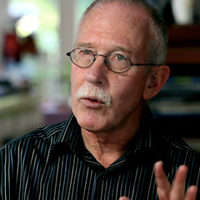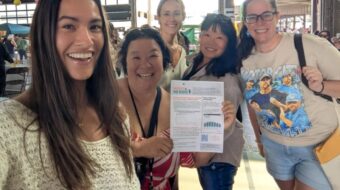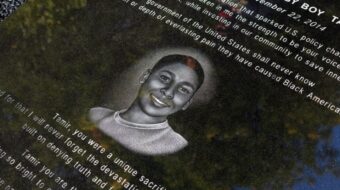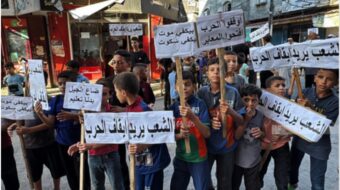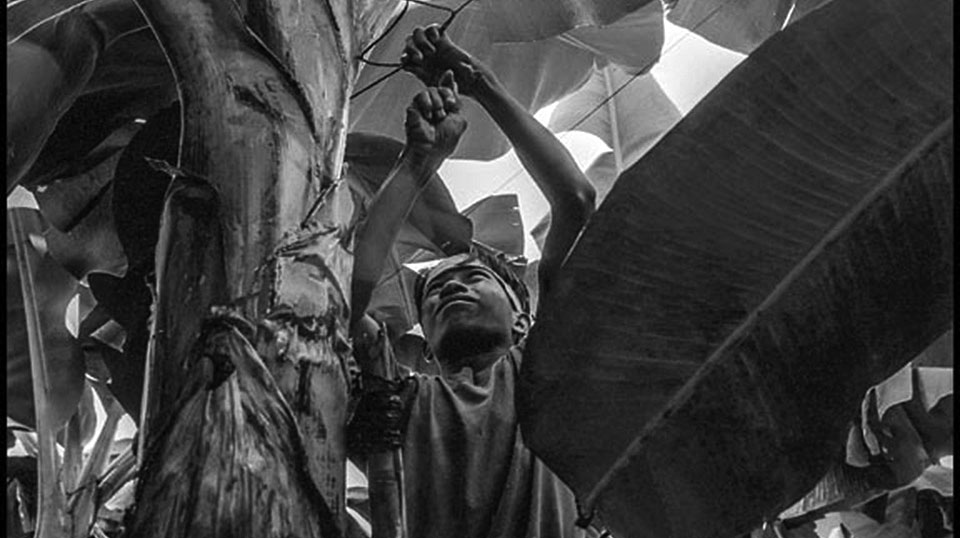
From the archives of photographer David Bacon, this collection tells of his visit to the banana plantations of Mindanao, in the Philippines, where he found children working in the trees, and a strike by members of banana cooperatives against the Dole Corporation, to end the poverty that sends children to work in the fields.
In 1997, I went to the Philippines to document child labor on the banana plantations producing for the Dole Corporation. In the Campostela Valley on Mindanao I found many children doing this work. Later, in Carmen, outside of Davao I took photographs and interviewed workers defending their cooperative, formed as a result of the land reform after the end of the Marcos dictatorship. They told me they were on strike against the low prices paid by the Dole Corporation, which forced many families to take their children to work with them.

At the Soyapa Farms plantation, a huge operation set up in 1992 by Stanfilco, a division of the Dole Corporation, it wasn’t hard to find the children – they were everywhere. In one corner I found five children from 11 to 17 years old chattering as they flattened out and recycled sheets of plastic, coated with chemicals, that are inserted between banana bunches as they grow.
From the shed I walked into the banana groves. The roof of broad leaves overhead created a hot green shade underneath, and the earth was slick with the dead and rotting material cut from the trunks of the trees. Here I found the youngest children, including Alan, nine, wielding a large sharp sickle he used to cut away the dead layers.
Other children I found in the groves had stopped going to school. Benedicto Hijara, at 15, had been working for three years.
After I returned from San Jose Campostela I went to see Koronado Apuzen, a lawyer who was helping agricultural workers set up cooperatives. Apuzen had worked with the National Federation of Labor, and many of the coops had grown out of the unions in that federation who’d formerly negotiated with Dole.
Workers in four big coops had been on strike against Dole for weeks. Before forming coops they’d worked for Dole as employees for decades. Using the Philippines’ land reform law passed after the fall of dictator Ferdinand Marcos, they’d gained ownership of the land.
But Dole controlled the export market, without which the coops couldn’t survive, and force a low price on the new coops. Under Dole’s new price to the coops, daily income dropped from 146 to 92 pesos, and workers lost all the medical and other benefits they had as direct employees. Faced with virtual starvation, the banana workers refused to keep on picking bananas.
Instead of finding workers inside the plantations themselves – after all, they now owned them – I found them in Occupy-style encampments under the trees just outside. Dole had hired guards and expelled the workers from their own land, shooting one striker.

One of the hardest things to hear was the frustrated dream of the freedom they expected to gain from land ownership. According to Jesus Relabo, a rank-and-file leader, “Owning the land is forever. It’s something you can give to your children.” Instead, workers had been forced to pull their children out of school. In some cases they’d gone to live with other relatives. And in other families they’d gone to work, as had the children in San Jose Campostela.
With the photographs and interviews, I first stopped in Honolulu and talked with Guy Fujimura, secretary-treasurer of the International Longshore and Warehouse Union Local 142, which still, at that time, had thousands of members working on Hawaii plantations. For many years the big sugar and pineapple companies shifted work from Hawaii to the Philippines and Central America. A lost strike in Mindanao would mean that agricultural labor there would become even cheaper. Guy ran the photographs and stories in the union newspaper so that his members, many of whom are Filipino, would understand the connection.
Back to California, the San Francisco Chronicle put the story and photos on its front page on Christmas day that year. The Institute for Food and Development Policy and its arm for political campaigns, Food First, turned the photographs and interviews into a background paper. The next year activists carried it to Seattle to use in the debates that led to the confrontation in Seattle in which protestors shut down the global meeting of the World Trade Organization.


